SEO
Best SEO Practices for Next.js Apps
Search Engine Optimization (SEO) ensures our blog app—where users filter posts by date or tags and admins manage content—reaches its audience via Google or Bing. A well-optimized post, like “Next.js Tips for Beginners,” should appear at the top of search results, driving organic traffic. Without SEO, even great content gets buried.
Picture this: You’ve added a post to our app, but it’s nowhere on Google. Why? Search engines couldn’t parse its structure or metadata. Today, we’ll harness Next.js, especially its App Router, to make our blog app a search engine star, using metadata, headers, and more.
Common Misconceptions:
- “Keywords alone win SEO.” Nope—structure, speed, and metadata are just as crucial.
- “SEO is set-and-forget.” It’s ongoing, especially with new posts or filters.
- “Next.js does SEO for you.” It provides tools, but you must use them right—especially in the App Router.
Let’s make our blog app shine!
Section 1: Understanding SEO in Next.js
SEO hinges on content, technical structure, and user experience. Next.js excels with features like server-side rendering (SSR), static site generation (SSG), incremental static regeneration (ISR), and the App Router’s metadata API. These ensure fast, crawlable pages that search engines love.
How Next.js Supports SEO
- Static Site Generation (SSG): Pre-renders pages for speed and crawlability, ideal for blog posts.
- Server-Side Rendering (SSR): Renders pages per request, great for dynamic routes like
/posts?tag=react. - Incremental Static Regeneration (ISR): Updates static pages without full rebuilds, perfect for post edits.
- Metadata API (App Router): Defines titles, descriptions, and social tags dynamically or statically.
- Headers Configuration: Controls caching, indexing, and more via route handlers or middleware.
- Image Optimization: The
<Image>component speeds up load times, a key ranking factor.
Example: Blog Post Page
Consider our /posts/[slug] page for a post like “Next.js Tips.” We want it to rank for “Next.js beginner tips.” Using the App Router, we’ll set metadata (title, description, Open Graph tags) and headers (cache-control, robots) to ensure it’s indexed and fast.
Misconception Alert: Many think the old <Head> component is the only way to set metadata. In the App Router, Next.js offers a cleaner metadata API, and headers are just as critical for SEO control.
Section 2: Implementing SEO Best Practices in Our Blog App
We’ll optimize our blog app’s /posts/[slug] page (individual posts) and /posts?tag=react route (filtered posts) using the App Router, focusing on metadata, headers, and other SEO essentials.
Step 1: Define Metadata in the App Router
The App Router’s metadata API lets you set page titles, descriptions, and social tags either statically (via export const metadata) or dynamically (via generateMetadata). This tells search engines and social platforms what your page is about.
Simple Example: For a static post page in app/posts/[slug]/page.tsx:
import { fetchPostBySlug } from '@/lib/api';
export async function generateMetadata({ params }: { params: { slug: string } }) {
const post = await fetchPostBySlug(params.slug);
return {
title: `${post.title} | My Blog`,
description: post.excerpt,
};
}
export default async function PostPage({ params }: { params: { slug: string } }) {
const post = await fetchPostBySlug(params.slug);
return (
<div>
<h1>{post.title}</h1>
<p>{post.content}</p>
</div>
);
}
This sets a unique title and description, making the page searchable and appealing in results.
Advanced Example: Add Open Graph and Twitter tags for social sharing:
export async function generateMetadata({ params }: { params: { slug: string } }) {
const post = await fetchPostBySlug(params.slug);
return {
title: `${post.title} | My Blog`,
description: post.excerpt,
openGraph: {
title: post.title,
description: post.excerpt,
images: [post.featuredImage],
url: `https://myblog.com/posts/${params.slug}`,
},
twitter: {
card: 'summary_large_image',
title: post.title,
description: post.excerpt,
images: [post.featuredImage],
},
};
}
How It Works: generateMetadata fetches the post and returns metadata dynamically. Search engines use title and description for snippets, while openGraph and twitter enhance social previews on platforms like X.
Advantages:
- Cleaner than
<Head>, with type safety in TypeScript. - Improves click-through rates with rich snippets. Disadvantages:
- Requires careful data fetching to avoid delays.
- Missing fields (e.g.,
images) can weaken social previews.
Step 2: Set Headers for SEO Control
Headers like Cache-Control, X-Robots-Tag, and Link (for canonical URLs) influence how search engines crawl and cache your pages. In the App Router, you can set headers in route handlers, middleware, or generateMetadata.
Example: Canonical URLs and Robots: In app/posts/[slug]/page.tsx, set a canonical URL to avoid duplicate content:
export async function generateMetadata({ params }: { params: { slug: string } }) {
const post = await fetchPostBySlug(params.slug);
return {
title: `${post.title} | My Blog`,
description: post.excerpt,
alternates: {
canonical: `https://myblog.com/posts/${params.slug}`,
},
robots: {
index: true,
follow: true,
},
};
}
Example: Cache Headers: For a static page, use headers() in a route segment config:
export const dynamic = 'force-static';
export async function generateMetadata({ params }: { params: { slug: string } }) {
const post = await fetchPostBySlug(params.slug);
return {
title: `${post.title} | My Blog`,
description: post.excerpt,
};
}
export default async function PostPage({ params }: { params: { slug: string } }) {
const post = await fetchPostBySlug(params.slug);
return (
<div>
<h1>{post.title}</h1>
<p>{post.content}</p>
</div>
);
}
export const headers = () => ({
'Cache-Control': 'public, max-age=31536000, immutable',
});
How It Works: The alternates.canonical field prevents duplicate indexing (e.g., /posts/nextjs-tips vs. /posts?tag=react). robots controls crawling (index: true allows indexing). Cache-Control ensures long-term caching for static pages, speeding up delivery.
Advantages:
- Prevents penalties for duplicate content.
- Optimizes crawl budgets and load times. Disadvantages:
- Incorrect headers (e.g.,
noindex) can hide pages. - Over-caching can serve stale content without ISR.
Step 3: Use SSG or ISR for Blog Posts
For /posts/[slug], SSG pre-renders posts, and ISR updates them dynamically. Combine with metadata for full SEO.
Example with ISR:
export const revalidate = 60; // Revalidate every 60 seconds
export async function generateMetadata({ params }: { params: { slug: string } }) {
const post = await fetchPostBySlug(params.slug);
return {
title: `${post.title} | My Blog`,
description: post.excerpt,
alternates: {
canonical: `https://myblog.com/posts/${params.slug}`,
},
};
}
export async function generateStaticParams() {
const posts = await fetchAllPosts();
return posts.map((post) => ({ slug: post.slug }));
}
export default async function PostPage({ params }: { params: { slug: string } }) {
const post = await fetchPostBySlug(params.slug);
return (
<div>
<h1>{post.title}</h1>
<p>{post.content}</p>
</div>
);
}
How It Works: generateStaticParams pre-renders all posts. revalidate: 60 updates pages every minute if edited in the admin panel. Metadata ensures proper indexing.
Advantages:
- Fast, crawlable pages boost rankings.
- ISR keeps content fresh. Disadvantages:
- Large blogs may slow builds.
- Incorrect
revalidaterisks stale data.
Step 4: Optimize Filtered Routes (/posts?tag=react)
Filtered routes are dynamic, so use SSR or dynamic rendering, paired with metadata.
Example: In app/posts/page.tsx:
export async function generateMetadata({
searchParams,
}: {
searchParams: { tag?: string };
}) {
const tag = searchParams.tag || '';
return {
title: tag ? `${tag} Posts | My Blog` : 'All Posts | My Blog',
description: `Browse ${tag || 'all'} blog posts.`,
alternates: {
canonical: tag
? `https://myblog.com/posts?tag=${tag}`
: 'https://myblog.com/posts',
},
};
}
export default async function PostsPage({
searchParams,
}: {
searchParams: { tag?: string };
}) {
const tag = searchParams.tag || '';
const posts = await fetchPostsByTag(tag);
return (
<div>
{posts.map((post) => (
<div key={post.slug}>{post.title}</div>
))}
</div>
);
}
How It Works: generateMetadata sets dynamic metadata based on the tag query. The canonical URL ensures unique indexing for each tag page.
Pitfall to Avoid: Don’t use SSG for highly dynamic routes—it’s overkill and slows builds. SSR or dynamic rendering is better here.
Step 5: Image Optimization
Images slow pages if unoptimized. Use Next.js’s <Image> component.
Example:
import Image from 'next/image';
export async function generateMetadata({ params }: { params: { slug: string } }) {
const post = await fetchPostBySlug(params.slug);
return {
title: `${post.title} | My Blog`,
description: post.excerpt,
};
}
export default async function PostPage({ params }: { params: { slug: string } }) {
const post = await fetchPostBySlug(params.slug);
return (
<div>
<h1>{post.title}</h1>
<Image
src={post.featuredImage}
alt={post.title}
width={800}
height={400}
priority
/>
<p>{post.content}</p>
</div>
);
}
How It Works: <Image> optimizes formats (e.g., WebP), lazy-loads, and uses alt for accessibility and SEO.
Advantages:
- Faster pages improve rankings.
- Accessible images aid crawlers. Disadvantages:
- Fixed dimensions can complicate responsive design.
Step 6: Structured Data (Schema Markup)
Structured data enables rich snippets. Use JSON-LD in a <script> tag.
Example:
import { fetchPostBySlug } from '@/lib/api';
export async function generateMetadata({ params }: { params: { slug: string } }) {
const post = await fetchPostBySlug(params.slug);
return {
title: `${post.title} | My Blog`,
description: post.excerpt,
};
}
export default async function PostPage({ params }: { params: { slug: string } }) {
const post = await fetchPostBySlug(params.slug);
const schema = {
'@context': 'https://schema.org',
'@type': 'BlogPosting',
headline: post.title,
image: post.featuredImage,
datePublished: post.date,
author: { '@type': 'Person', name: post.author },
};
return (
<div>
<script
type="application/ld+json"
dangerouslySetInnerHTML={{ __html: JSON.stringify(schema) }}
/>
<h1>{post.title}</h1>
<p>{post.content}</p>
</div>
);
}
How It Works: The schema tells Google this is a blog post, potentially showing richer results.
Advantages:
- Enhances search visibility.
- Drives clicks with rich snippets. Disadvantages:
- Needs updates with content changes.
Section 3: Common SEO Pitfalls to Avoid
- Duplicate Content: Without canonical URLs,
/posts/nextjs-tipsand/posts?tag=reactmight compete. Usealternates.canonicalingenerateMetadata. - Slow Load Times: Unoptimized images or JavaScript hurt rankings. Use
<Image>and code-split. - Missing Sitemap: Generate
sitemap.xmlwithnext-sitemapto index all posts. - Incorrect Headers: Setting
noindexaccidentally hides pages. Double-checkrobotsin metadata. - Keyword Stuffing: Overusing “Next.js tips” looks spammy. Write naturally.
Conclusion: Key Takeaways and Best Practices
SEO makes our blog app discoverable. The App Router’s metadata API and headers give us precise control over titles, descriptions, and crawling behavior. Here’s what to remember:
- Use
<strong>generateMetadata</strong>for dynamic titles, descriptions, and social tags. - Set headers like
Cache-Controlandrobotsfor performance and indexing. - Leverage SSG/ISR for fast, crawlable posts.
- Optimize images with
<Image>. - Add structured data for rich snippets.
Best Practices:
- Audit with Google Search Console regularly.
- Test with Lighthouse for SEO and performance.
- Keep metadata and headers consistent across routes.
Common Pitfalls:
- Don’t skip canonical URLs or sitemaps.
- Avoid SSR for static content—use SSG/ISR.
- Never neglect mobile responsiveness.
With these practices, our “Next.js Tips” post will climb Google’s ranks, delighting users and admins alike. Let’s optimize and conquer search results!
Slides

Want your blog app to top Google searches? SEO is the key! In this lecture, we’ll use Next.js’s App Router to optimise our blogging app’s posts and filtered routes. We will learn about metadata, headers, and more to boost rankings.

Our blog app lets users filter posts and admins manage content. Without SEO, posts get lost. Today, we’ll use NextJS to optimise our blog, making it a search engine star.
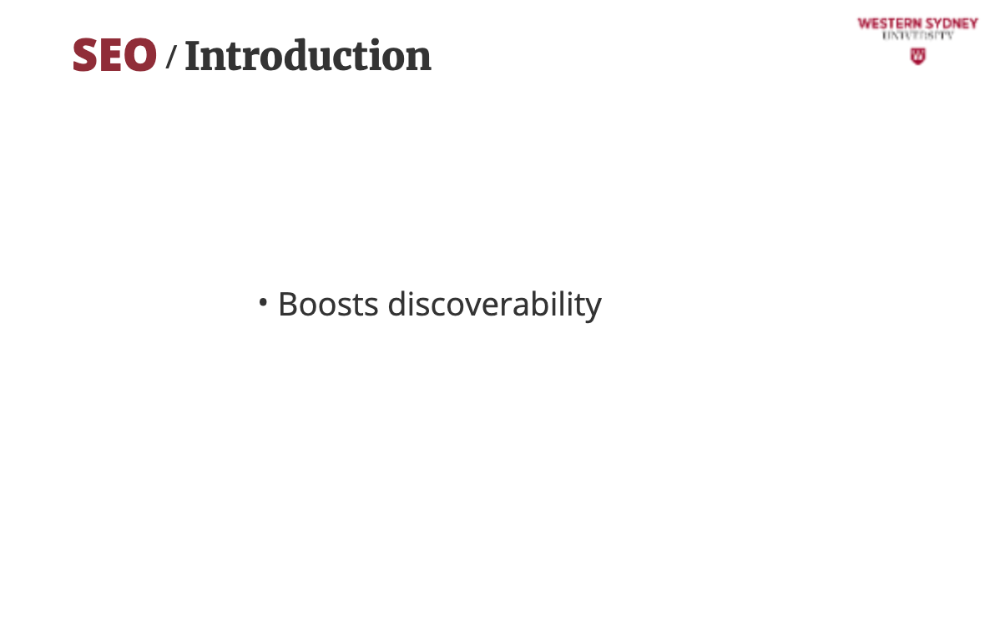
SEO is important, as your page gets left behind in all important searches. SEO ensures our blog posts, like “NextJS Tips,” appear in Google searches, driving organic traffic to users browsing by tag or date.

NextJS simplifies SEO, with the App Router’s metadata API and headers making pages crawlable and fast, key for rankings.
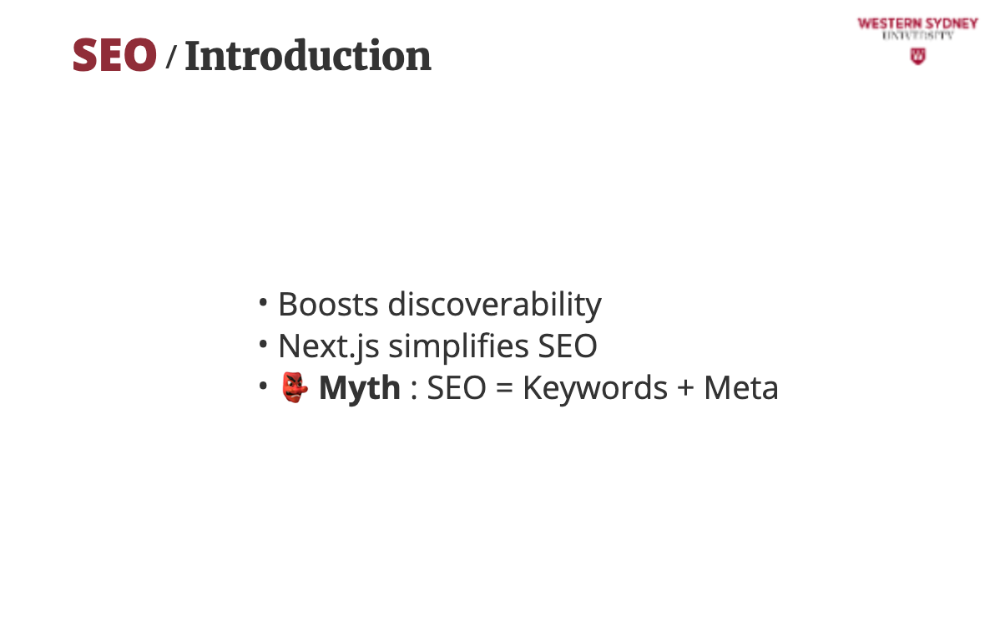
Many think keywords and metadata alone win SEO, but structure and speed are equally vital. Check out
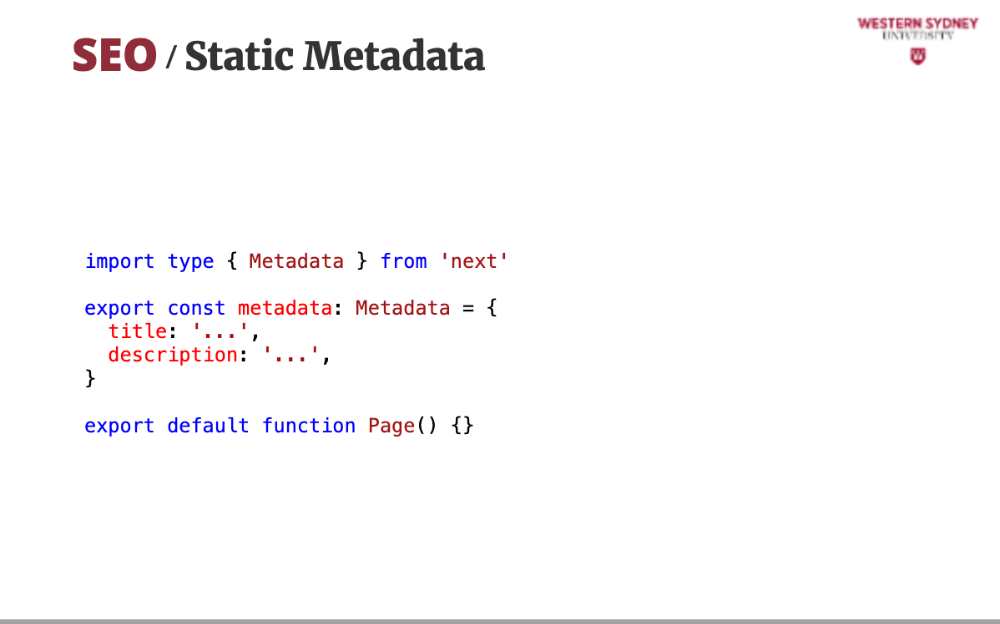
The simplest way to start SEO is with metadata. NextJS has a Metadata API that can be used to define your application metadata. In this example, we show that you can simply export a metadata variable with static metadata.
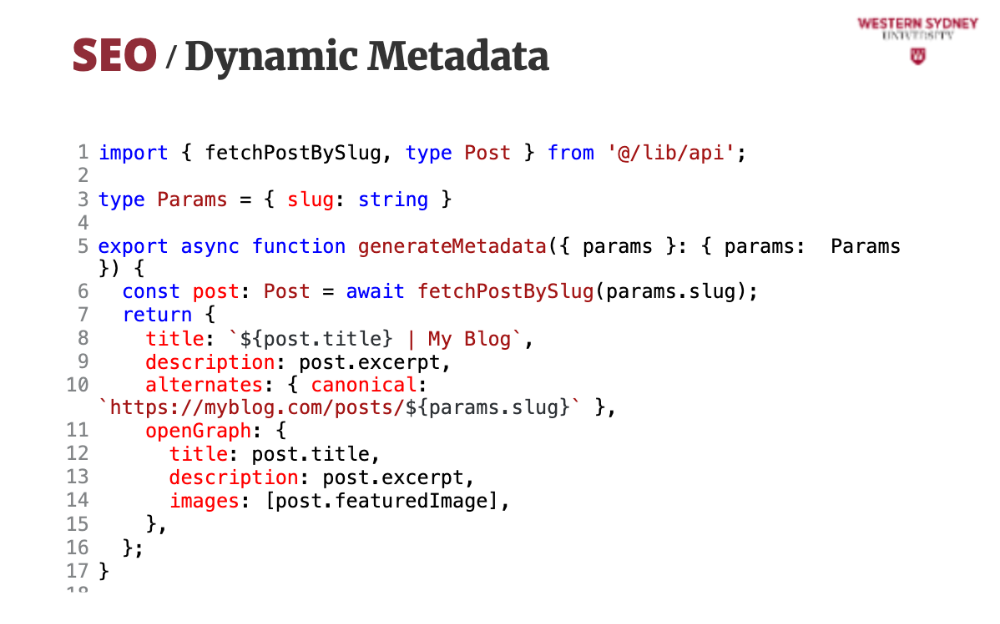
For dynamic pages, we can also generate meta-data dynamically using the generateMetadata function.
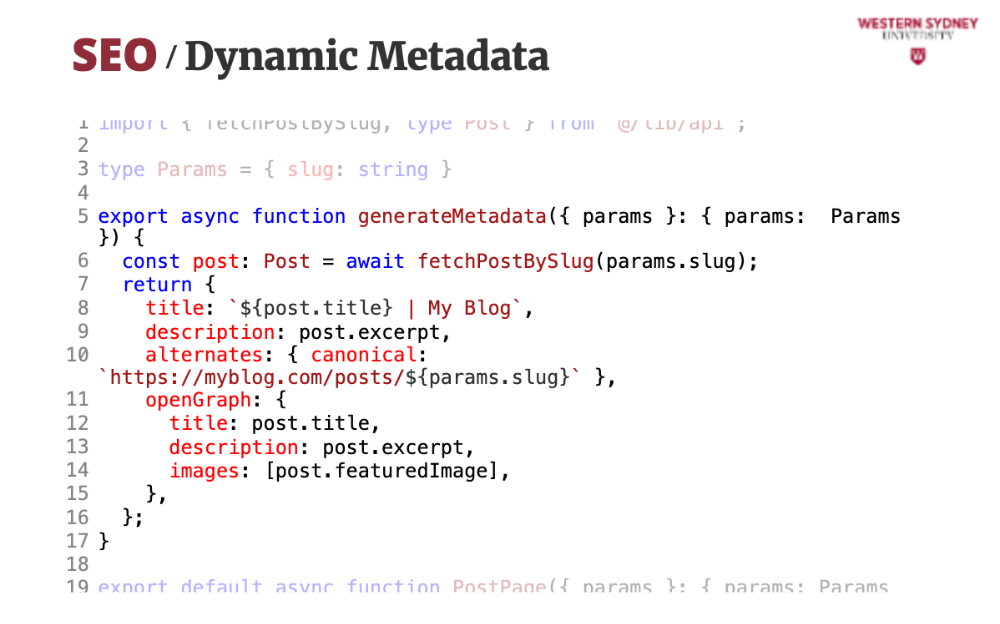
Our implementation of the generateMetadata function defines titles and descriptions per page, enhancing snippets.
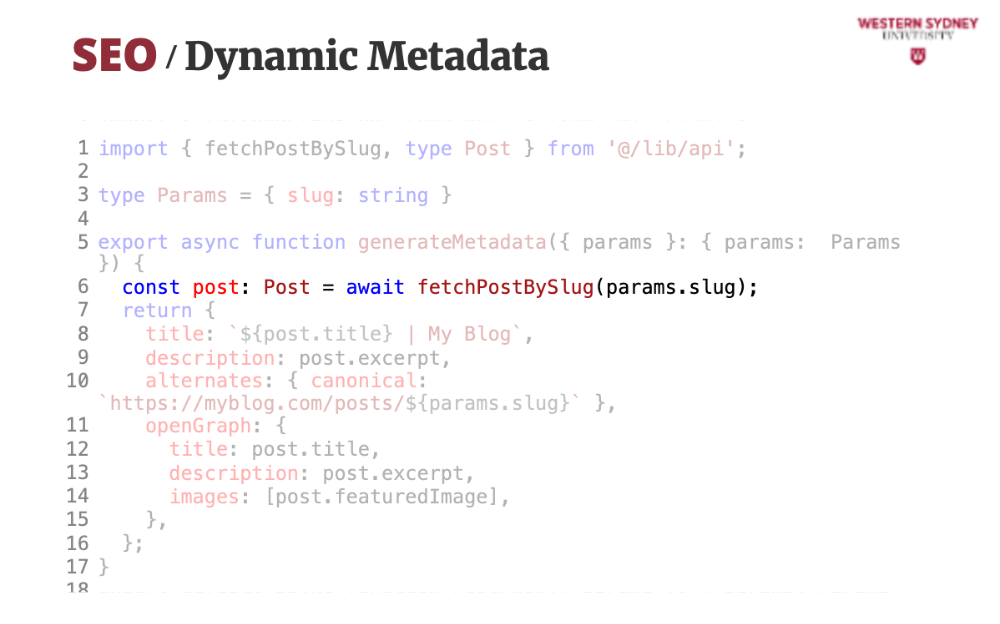
generateMetadata fetches post data, setting up SEO dynamically for each slug.
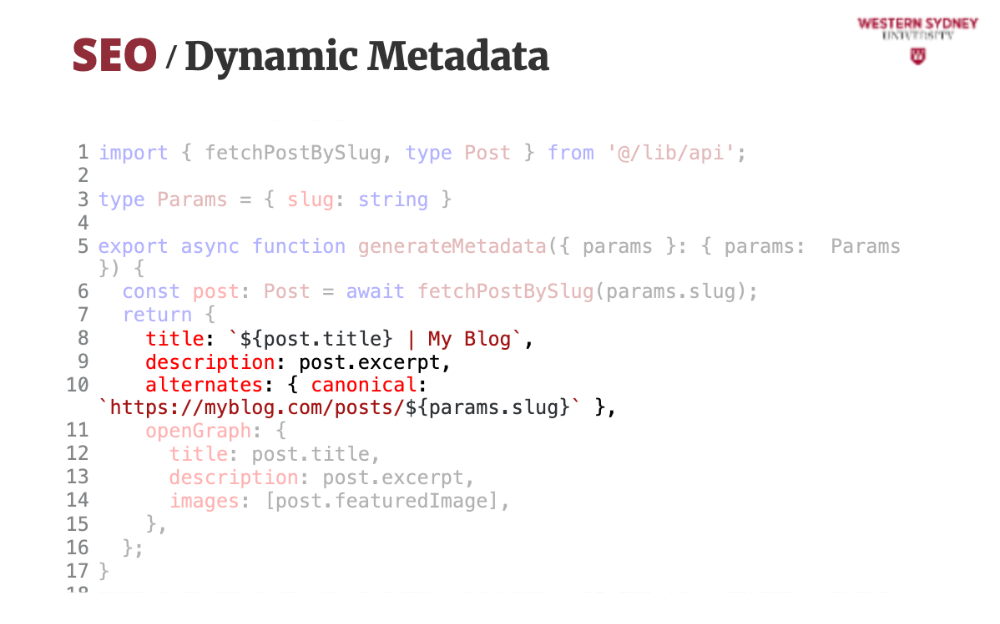
The metadata object sets a unique title, description, and canonical URL, ensuring proper indexing and social previews. Canonical URLs allow you to define one URL for pages that you can access from different URLs.
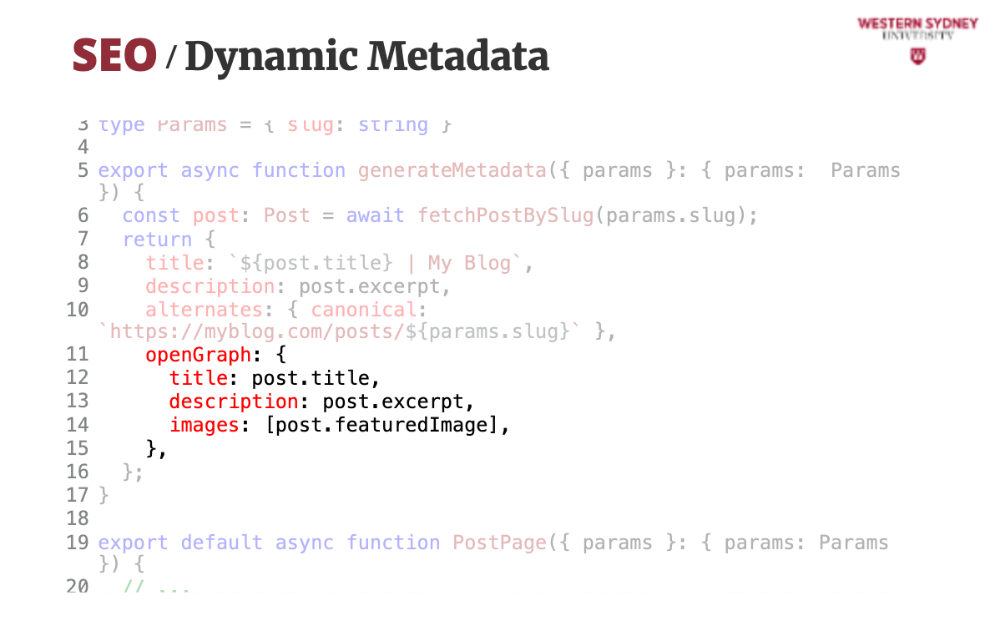
Open Graph tags make posts shareable on Facebook, you can add similar tags for Twitter.
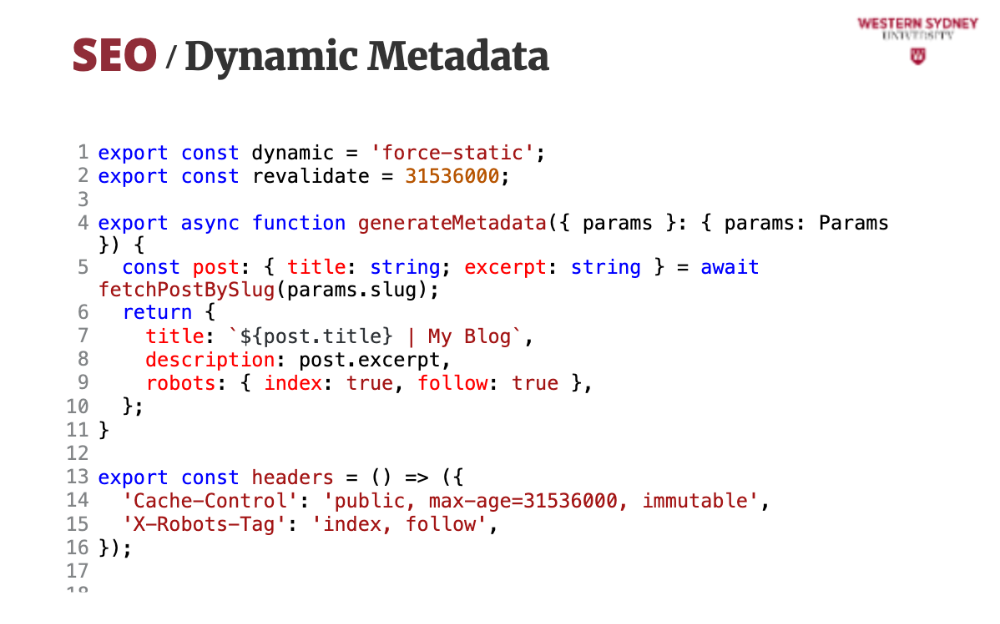
Let's check out another example.
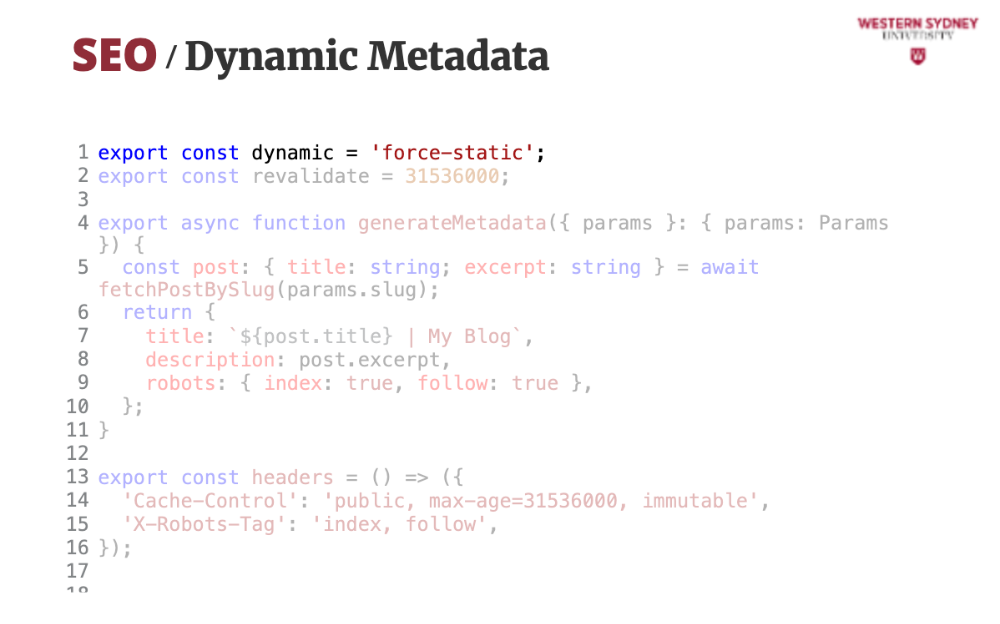
Here, we force static site generation, which will generate a static page for every blog posts in our database. This is beneficial for speed and SEO rankings.
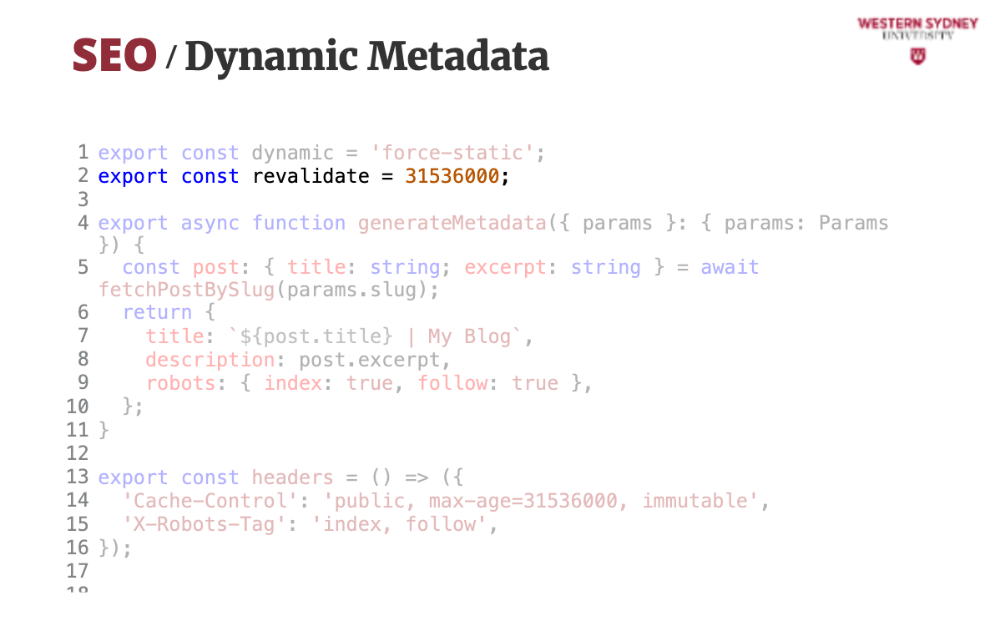
We will note that the static version is valid for 1 year, and after 1 years a new version should be generated.
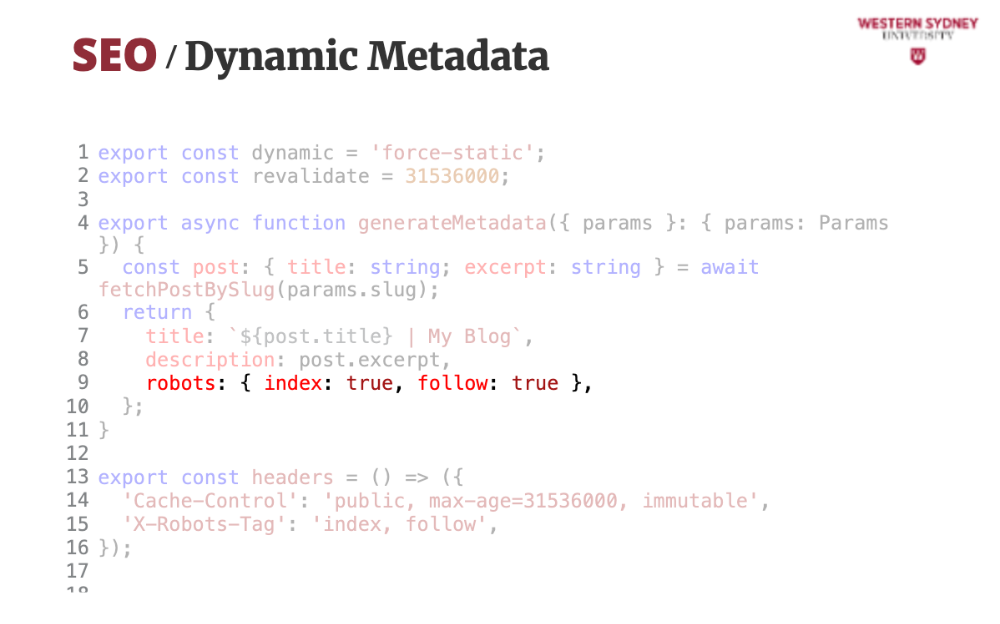
The robots property provides instructions for web and AI crawlers, allowing indexing, making the post discoverable.
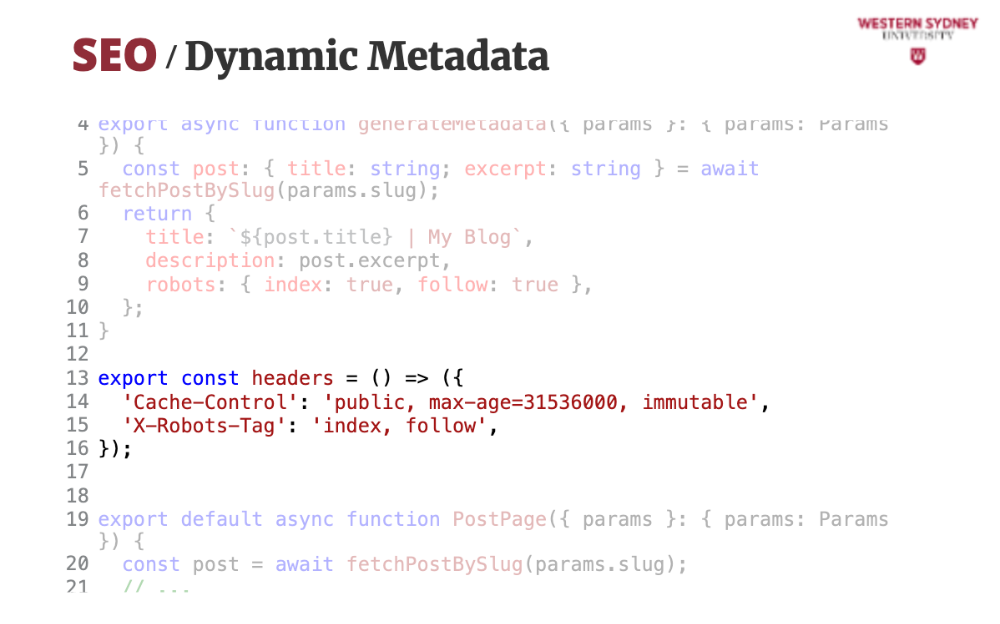
Last, we also set some custom headers, caching the page for a year and reinforce indexing, optimising delivery.
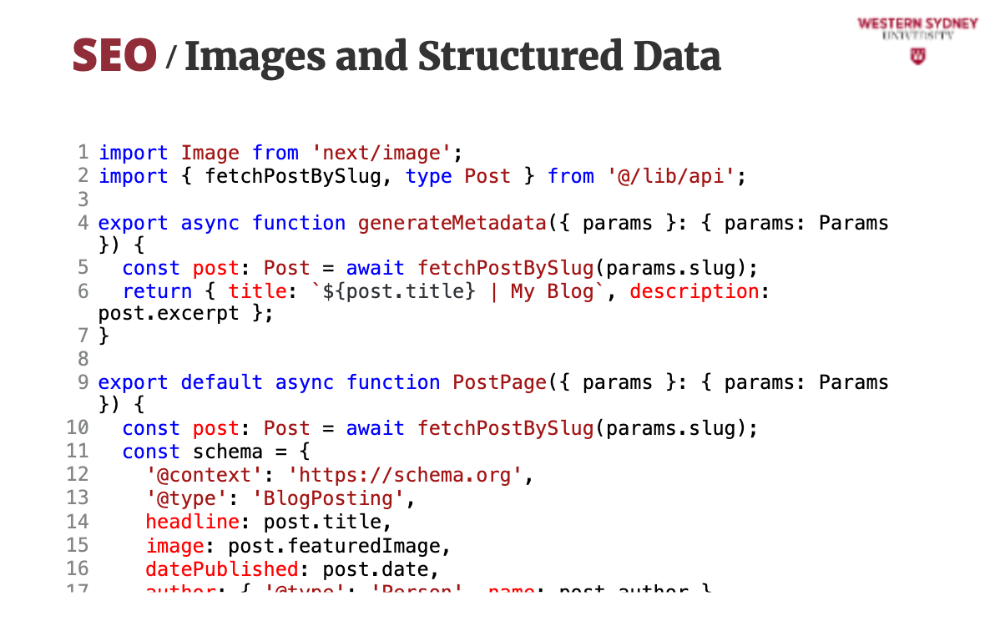
Yet, as we mentioned earlier, SEO is not just about metadata. Performance and semantic understanding help as well.
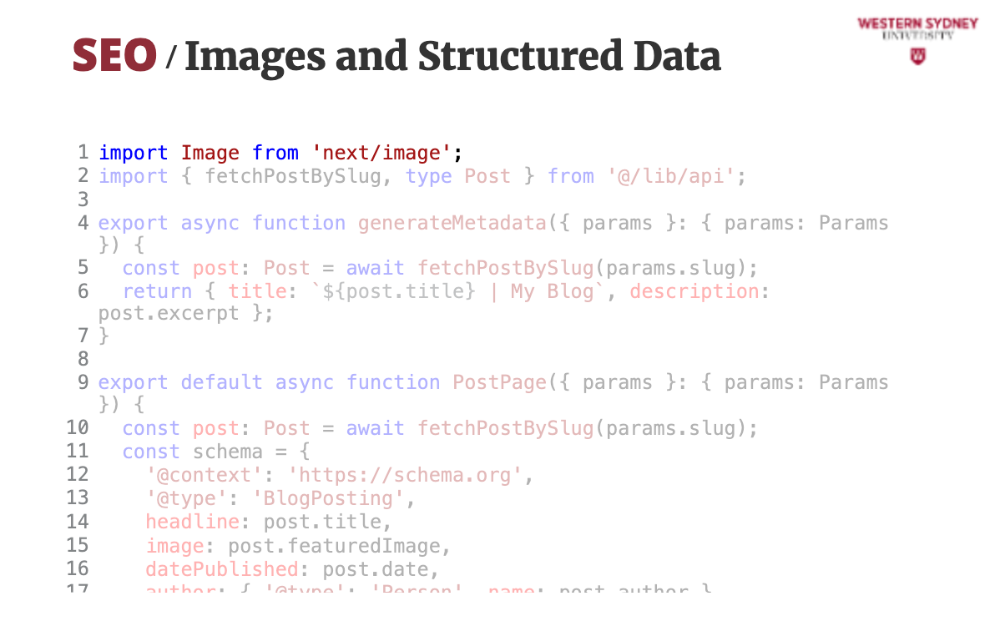
With NextJS, you should use the Image component, which ensures fast, SEO-friendly images for blog posts.
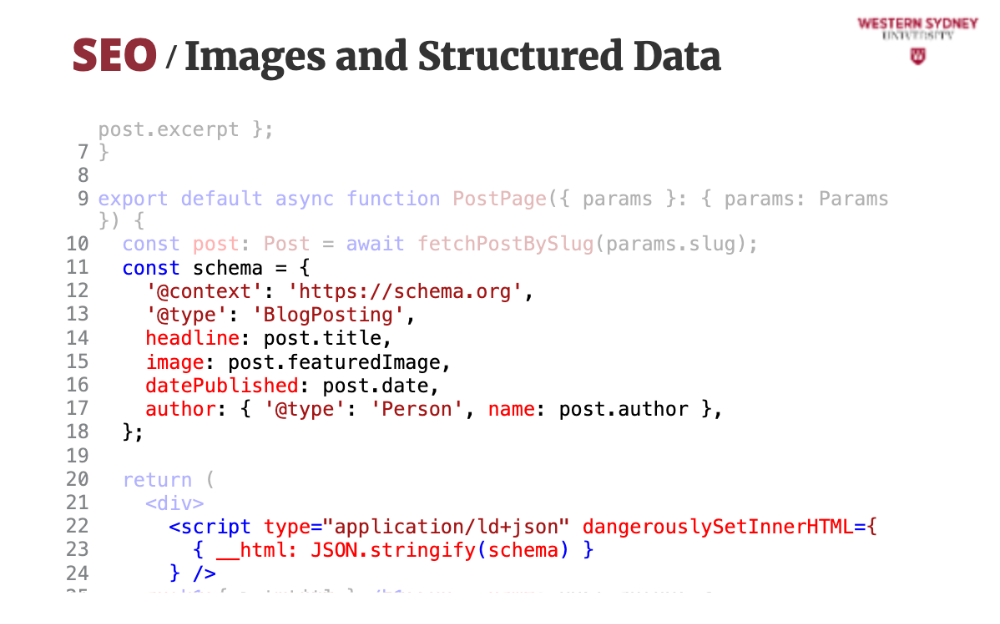
You can use schema markup, which tells Google this is a blog post, boosting rich snippets.
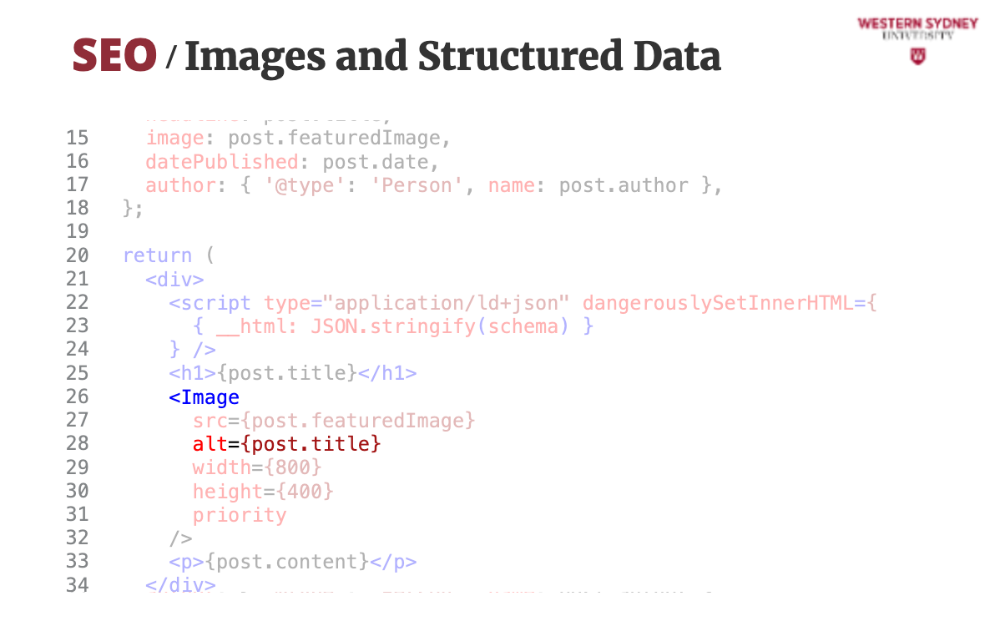
Last, using alt attribute makes images accessible and crawlable. In general, respecting accessibility guidelines will boost your SEO ranking.

Let's wrap up!

Use metadata export or generateMetadata to ensure unique, crawlable pages.
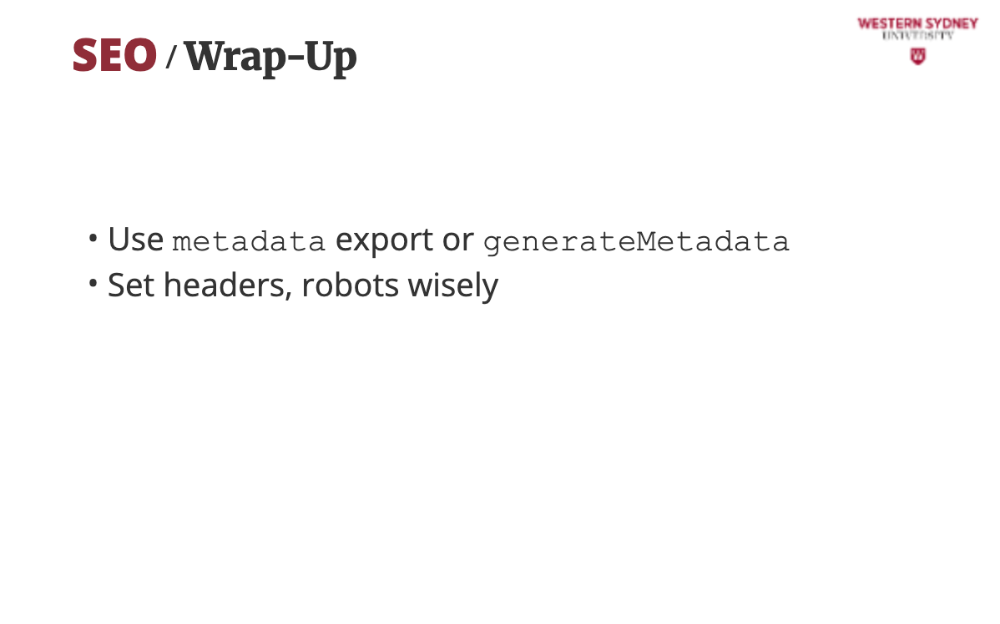
Set headers wisely and control caching and robots control speed and indexing
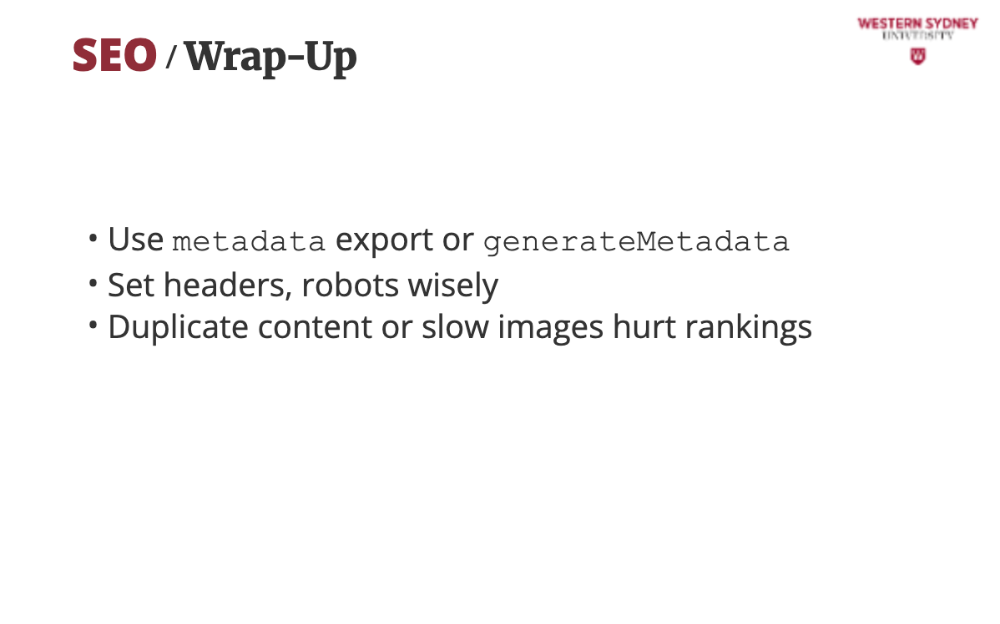
If you have duplicate content or slow images, it hurts rankings
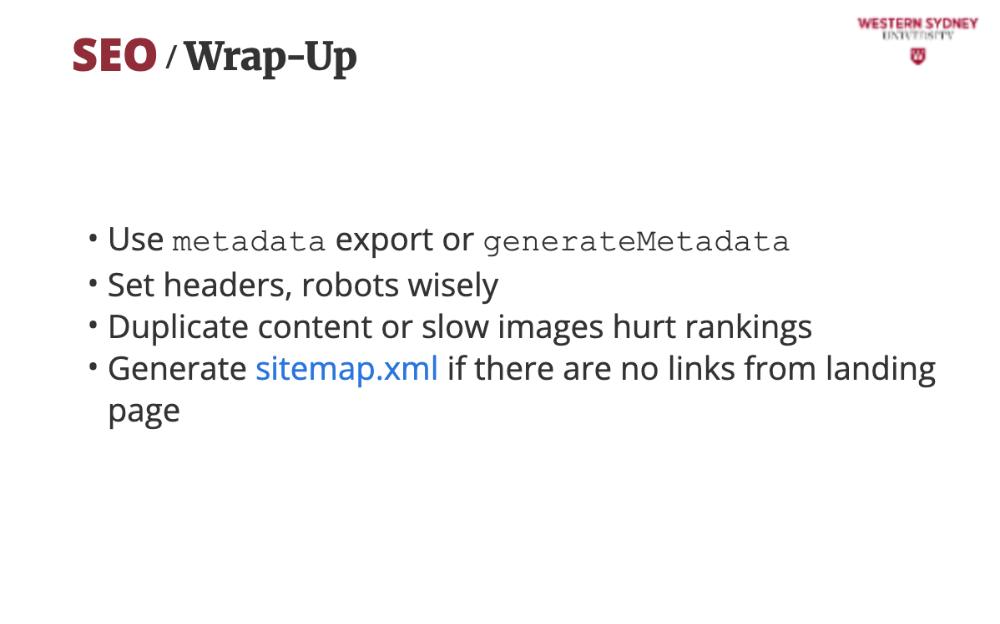
We did not discuss this, but you can help crawlers to spell out all the urls the robots can visit, by providing sitemap xml file. This is very helpful when you can not provide all the links to your content from the landing page or there are no back links.
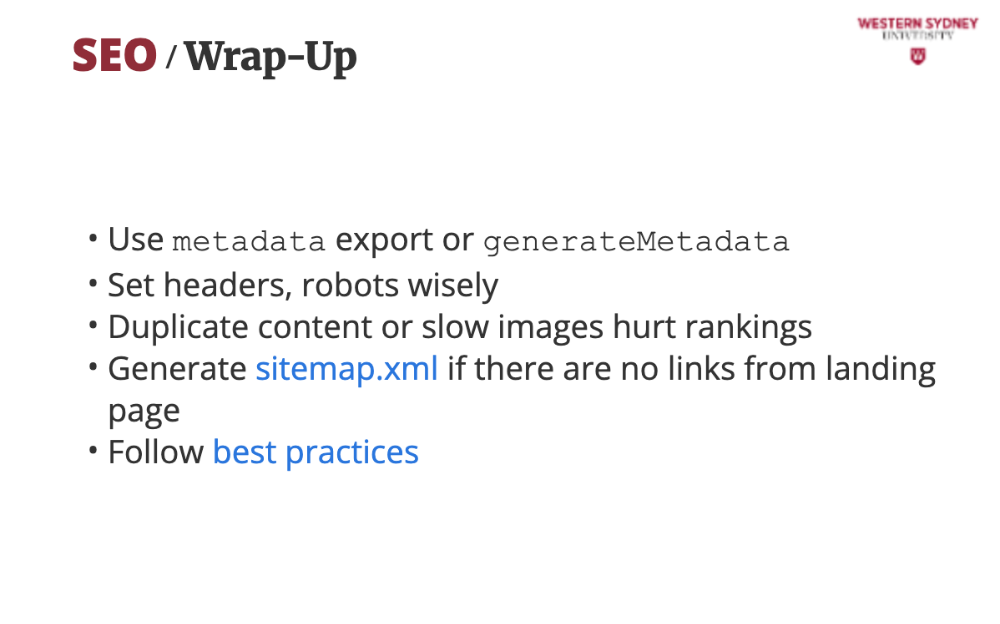
Good SEO is a work of art, and many businesses pay a lot of money to do it by professional companies. You can start learning about best practices on Google Central! Now, consider yourself SEO acolytes! Good luck!